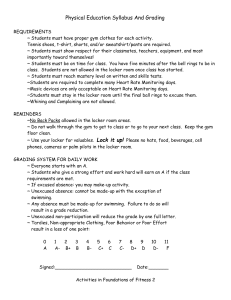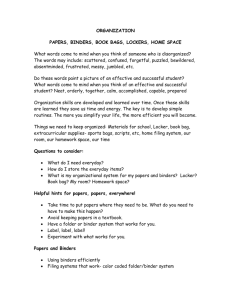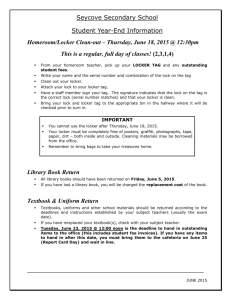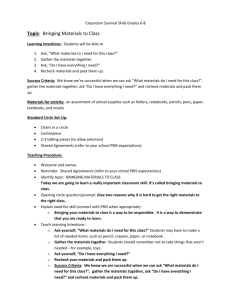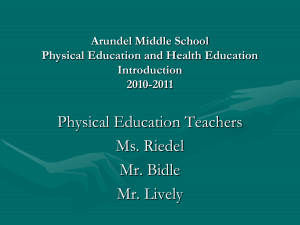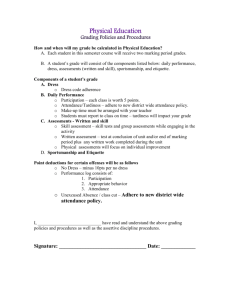Student Organizational Skills
advertisement
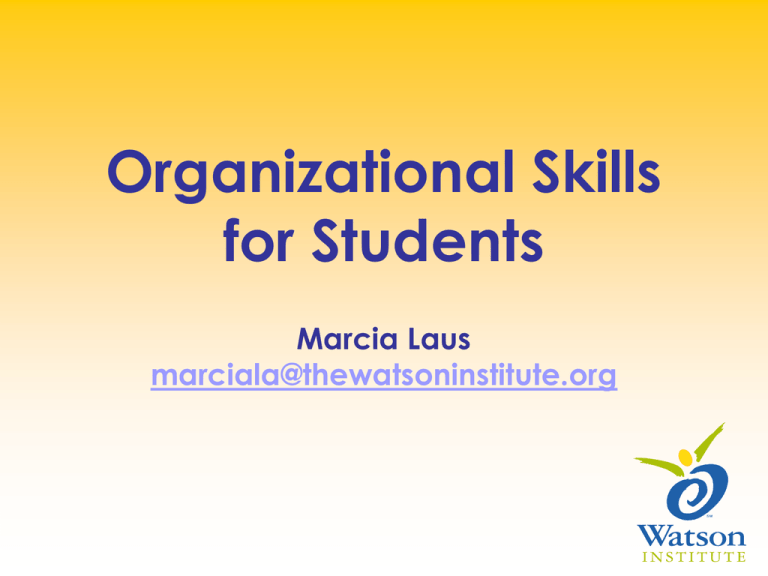
Organizational Skills for Students Marcia Laus marciala@thewatsoninstitute.org Why Are Kids Disorganized? Frontal Cortex & Executive Function Provides executive control – all purposeful actions A neuropsychological process in the pre frontal cortex This process underlies purposeful behaviors such as: • Planning & organizing • Attention & concentration • Flexibility to try new problem solving strategies • Abstract & complex thinking • Decision making And More: • Self-monitoring for accuracy • Progress towards a goal • Emotional responses • Judgment & reasoning • Inhibit incorrect/inappropriate responses Why is Organization Difficult for Adolescents Changing classes – no “home base” More teachers with different teaching styles Expectations for independence and self-regulation higher The “Adolescent Brain” The Adolescent Brain Just prior to puberty – a lot of grey matter is created, neurons develop, myelin is formed – transmission of electrical impulses speed up This takes place in the frontal cortex of the brain – essential for such functions as response inhibition, emotional regulation, analyzing problems and planning – Executive Functions Executive functions continue to develop through young adulthood (earlier in girls than in boys) Synaptic pruning – “use it or lose it” – eliminates weaker synapses – strengthens stronger connections Teaching Organization Labeling Model organization Options – involve student in planning organization Frequent checks (binder, planner,) Routines • Where to do homework • When to do homework • Get ready the night before P.A.C.K. Purge Accessorize Categorize Keep It Up The Organized Student by Donna Goldberg Key Organizational Skills Organization at School Time Management Organization at Home The Organized Student by Donna Goldberg Organizing Tools 3 ring binder or accordion file Desk organization Locker organization Planner Desktop filing system The Organized Student by Donna Goldberg The Binder(s) Tools (dividers, pencil pouch, 3 hole punch, pockets) Color coding Schedule How many? AM/PM; one for each class; one for entire day? Tools for Binder Organization Locker Organization Zones: • Books • Supplies • Personal Belongings Locker Organization System: • All books start on top shelf in AM • When putting books in after class they either go: on bottom shelf OR In backpack (homework) Locker Organization Locker Organization Include • Schedule • Color coding • Organizing tools Locker Organization www.organizeeverything.com www.amazon.com www.lockerdog.com Tools for Locker Organization Other Locker Organizational Tools www.boarddudesdirect.com Desk Organization Other Desk Organization Ideas Chair “sacks” Loose paper folder or envelope Boxes or office trays for books Mailboxes (gets loose papers out of desk) Accordion file folders Other???? Locker and/or Desk Organization Periodic Checks: • Checklist • Motivators • Assistance with “decluttering” Locker No loose papers Books on shelf or in backpack Coat and backpack on hook All small items in containers ________________________________ Assignment Planner Teacher check or Peer check • after giving assignment – have each student explain it to a peer • Peers check each others planner Parent check at home Routine and Time Teach to abbreviate Teach to prioritize – parents help at home with this!!! Work to do checklist Long Term Assignment Planning Work To Do: ___________________________ ___________________________ ___________________________ ___________________________ ___________________________ ___________________________ Work To Do Checklist Long Term Project Assignment: ___________________________ _______________________________________ Steps to complete: Monday Week 1 Week 2 Week 3 Tuesday Date assigned: by when: Wednesday Date due: when complete Thursday Friday Notes: Saturday Sunday What Can Parents Do? Begin slowly. Focus on one problem at a time Start with “stuff management” Make sure your child has a proper study space Help your child develop a study schedule Have your child study or read even when she has no homework Check the planner, check the backpack and folders Teach your child to take (approp) breaks From: Get Organized Without Losing It by Janet Fox Organization at Home Homework Area Desktop File Box “Toolkit” Calendar (“where is everybody?”) Habits and Routines!! Avoid the Morning Rush Visual supports – schedules, checklists, post its, etc. “A place for everything and everything in its place” Schedule times for regular “decluttering” Desktop Organizer for Homework Desk How to Study Mnemonic devices Repetition Variety of ways Movement breaks or movement while studying Music? On or Off?? Ongoing – (rather than cramming) Websites www.howtostudy.org www.studygs.net Schedules After School Schedule Tell Me About Today Mini schedules Work To Do Checklist Work Systems Schedules you can purchase Tell Me About Today Available at Target


